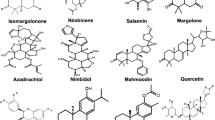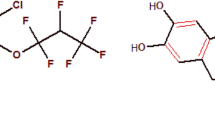Abstract
Juvenile hormone is an important hormone which controls the developmental process in the lepidopteran insects, hence, referred as insect growth regulator. Juvenile hormone binding proteins are the carrier of juvenile hormone from the site of secretion to the site of action and play vital role in juvenile hormone action. We have designed four different juvenile hormone analogs incorporating sulfonamide and heterocyclic moieties using computer-aided tools. All analogs (T3–T6) gave comparative energy profile in comparison to in use insect growth regulators like fenoxycarb (T2) and pyriproxyfen (T1). Further, theses analogs have been screened on biological model Galleria mellonella (wax moth) for their mortality rate. All analogs were evaluated using three different concentrations (1000, 1500, and 2000 ppm) and five different exposure periods (2, 4, 6, 8, and 10 h). In vivo study showed that analog N-(1-isopropyl-2-oxo-2-morpholino-ethyl) toluene sulfonamide (T6) and N-(1-isopropyl-2-oxo-2-piperidino-ethyl) toluene sulfonamide (T4) exhibit the good larval mortality at lower concentration (1000 ppm) after 8 h exposure in comparison to pyriproxyfen (T1) and fenoxycarb (T2). The findings demonstrate the effectiveness and validity of the virtual screening approach (docking) and provide a starting point for the development of novel juvenile hormone analogs to counter G. mellonella.





Similar content being viewed by others
References
Wyatt, G. R., & Davey, K. G. (1996). Cellular and molecular action of juvenile hormone.2. Roles of juvenile hormone in adult insects. Advances in Insect Physiology, 26, 1–155.
Gilbert, L. I., Graner, N. A., & Roe, R. M. (2000). The juvenile hormones: historical facts and speculation on future research directions. Insect Biochemisry and Molecular Biology, 30, 617–644.
Retnakaran, A., Granett, J., & Ennis, T. (1985). Insect growth regulators. In G. A. Kerkut & L. I. Gilbert (Eds.), Comprehensive Insect Physiology Biochemistry and Pharmacology (pp. 529–601). Oxford, U.K.: Pergamon Press.
Slama, K., Romaouk, M., & Sorm, F. (1974). Insect hormones and bioanalogs (p. 477). Wien, New York: Springer.
Furuta, K., Fujita, N., Ibushi, T., Shiotsuki, T., Yamada, N., & Kuwano, E. (2010). Synthesis and anti-juvenile hormone activity of ethyl 4-[(6-substituted 2, 2-dimethyl-2H-chromen-7-yl)methoxy]benzoates. Journal of Pesticide Science, 35(4), 405–411.
Goh, W. K., Rice, S. A., & Kumar, N. (2005). Theoretical study of molecular determinants involved in signal binding to the TraR protein of Agrobacterium tumefaciens. Molecules, 10, 1263–1271.
Roe, R. M., Anspaugh, D. D., Venkatesh, K., Linderman, R. J., & Graves, D. M. (1997). A novel geminal diol as a highly specific and stable in vivo inhibitor of insect juvenile hormone esterase. Archives of Insect Biochemistry and Physiology, 36, 165–179.
Bhattacharjee, A. K., Gupta, R. K., Ma, D., & Karle, J. M. (2000). Molecular similarity analysis between insect juvenile hormone and N, N-diethyl-m-toluamide (DEET) analogs may aid design of novel insect repellents. Journal of Molecular Recognition, 13(4), 213–220.
Wimmer, Z., Kuldova, J., Hrdy, I., & Bennettova, B. (2006). Can juvenogens, biochemically targeted hormonogen compounds, assist in environmentally safe insect pest management? Insect Biochemistry and Molecular Biology, 36(6), 442–453.
Kad, G. L., & Kalra, R. (1999). Juvenile Hormone analogs active on mosquitoes: synthesis and juvenile hormonal activity of newly synthesized long chain alkoxy alkyl phenyl ethers. Archives of Pharmacal Research, 22(5), 502–506.
Awasthi, P., & Mahajan, R. K. (2008). Synthesis of some sulphonamide insect juvenile hormone—part I. Indian Journal of Chemistry, 47(B), 1291–1297.
Jurcek, O., Wimmer, Z., Svobodova, H., Bennettova, B., Kolehmainen, E., & Drasar, P. (2009). Preparation and preliminary biological screening of cholic acid–juvenoid conjugates. Steroids, 74, 779–785.
Wheeler, D. E., & Nijhout, H. F. (2003). A perspective for understanding the modes of juvenile hormone action as a lipid signaling system. Bio Essays, 25, 994–1001.
Gaubard, Y. (2005) Juvenile hormone binding proteins-importance on the JH action. Lund University, Introductory paper no 168.
Kramer, K. J., Dunn, P. E., Peterson, R. C., & Law, J. H. (1976). Interaction of juvenile hormone with binding proteins in hemolymph. In L. I. Gilbert (Ed.), The Juvenile Hormones (pp. 327–341). New York: Plenum Press.
Goodman, W., Ohern, P. A., Zaugg, R. H., & Gilbert, L. I. (1978). Purification and characterization of a juvenile hormone binding protein from the hemolymph of the fourth instar tobacco hornworm, Manduca sexta. Molecular and Cellular Endocrinology, 11, 225–242.
Wieczorek, E., & Kochman, M. (1991). Conformational change of the haemolymph juvenile-hormone-binding protein from Galleria mellonella (L). European Journal of Biochemistry, 201, 347–353.
Krzyżanowska, D., Lisowski, M., & Kochman, M. (1998). UV-difference and CD spectroscopy studies on juvenile hormone binding to its carrier protein. Journal of Peptide Research, 51, 96–102.
Kołodziejczyk, R., Bujacz, G., Jakob, M., Ozyhar, A., Jaskolski, M., & Kochman, M. (2008). Insect juvenile hormone binding protein shows ancestral fold present in human lipid-binding proteins. Journal of Molecular Biology, 377, 870–881.
Touhara, K., & Prestwich, G. D. (1992). Binding site mapping of a photoaffnity-labeled juvenile hormone binding protein. Biochemical and Biophysical Research Communications, 182, 466–473.
Hejno, K., & Sorm, F. (1976). Synthesis of 8-oxa analogs of acyclic juvenoidal substances. Collection of Czechoslovak Chemical Communications, 41, 151–157.
Hejno, K., & Sorm, F. (1980). Cyclic analogs of insect juvenile hormone. Collection of Czechoslovak Chemical Communications, 45, 1734–1743.
Odinokov, V. N., Kukovinets, O. S., Zainullin, R. A., & Tolstikov, G. A. (1992). The synthesis of insect juvenile hormones and their analogs. Russian Chemical Reviews, 61(7), 731–762.
Wawrzeńczyk, C., Derdzińnski, K., & Zabza, A. (1984). Insect growth regulators. XIV. Juvenoids with cyclopentene ring. Synthesis of isopropyl 3,7-dimethyl-10-(2,2,3-trimethyl-cyclopent-3-en-1-yl)-deca-2,8-dienoate and -deca-2,4,8-trienoate. Journal für Praktische Chemie, 326, 213–221.
Kahovcova, J., Romanuk, M., & Sorm, F. (1978). Aliphatic-aromatic ethers with a cycloacetal bond in the molecule. Collection of Czechoslovak Chemical Communications, 43, 1502–1510.
Awasthi, P., & Sharma, P. (2012). In silico screening of the juvenile hormone analogs with juvenile hormone binding protein of Galleria mellonella—a docking study. SAR and QSAR in Environmental study., 23(7–8), 607–625.
Awasthi, P. Sharma, P. (2012) Docking study of synthesized juvenile hormone analogs as an insect growth regulator. 14th International Conference on Modelling and Simulation, (UKSim), 113-116: ISBN: 978-1-4673-1366-7.
Awasthi, P., & Sharma, P. (2013). Designing and Binding mode prediction of juvenile hormone analogs as potential inhibitor for Galleria mellonella. Journal of Computer Science &System Biology, 6, 106–111.
Ali, E. S. H., Nassar, F. I., Badawi, A., & Afify, S. A. (2010). Physical properties and biological applications of novel substituted biphenyl-sulfonamides. International Journal of Genetics and Molecular Biology, 2(5), 78–91.
Morris, G. M., Goodsell, D. S., Halliday, R. S., Huey, R., Hart, W. E., Belew, R. K., & Olson, A. J. (1998). Automated docking using a lamarckian genetic algorithm and empirical binding free energy function. Journal of Computational Chemistry, 19, 1639–1662.
M. John, Organic Chemistry. 5th edition. Brooke/Cole. (2000), 1002.
Robert, T. M., & Robert, N. B. (1992). Organic Chemistry (6th ed.). New Jersy: Prentice-Hall international Inc. pp 859-876.
Ashfaq, M., Al–Tememi, N. K., & Ahmed, S. (2005). Effect of artificial diets on some parameters of greater wax moth Galleria mellonella L. under optimum conditions. Journal of Agricultural Reseach, 43(3), 223–228.
Amiri, A., Bandani, A. R., & Darvishzadeh, A. (2012). Effects of the insect growth regulators Methoxyfenozide and Pyriproxyfen on adult diapause in sunn pest Eurygaster integriceps (Hemiptera: Scutelleridae). Journal of Agricultural Science Technology, 14, 1205–1218.
Ghoneim, K. S., Hamadah, K. S., & Tanani, M. A. (2012). Protein disturbance in the haemolymph and fat body of the desert locust Schistocerca Gregaria as a response to certain insect growth regulators. Bulletin Environment Pharmacology Life Science, 1(7), 73–83.
Fahmy, N. M. (2012). Impact of two insect growth regulators on the enhancement of oxidative stress and antioxidant efficiency of the cotton leaf worm, Spodoptera littoralis (Biosd.). Egyptian Academic Journal of Biological Science, 5(1), 137–149.
Mojaver, M., & Bandani, A. R. (2010). Effects of the insect growth regulator pyriproxyfen on immature stages of sunn pest, Eurygaster Integriceps Puton (Heteroptera: Scutelleridae). Munis Entomology Zoology, 5(1), 187–197.
Esposito, E. X., Baran, K., Kelly, K., & Madura, J. D. (2000). Docking of sulfonamides to carbonic anhydrase II and IV. Journal of Molecular Graphics and Modeling, 18, 283–289.
Jones, G., Wozniak, M., Chu, Y. X., Dhar, S., & Jones, D. (2001). Juvenile hormone III-dependent conformational changes of the nuclear receptor ultraspiracle. Insect Biochemistry and Molecular Biology, 32, 33–49.
Wilhelm, T., & Nikolajewa, S. (2004). A new classification scheme of the genetic code. Journal of Molecular Evolution, 59, 598–605.
Doig, A. J., & Williams, D. H. (1992). Binding energy of an amide-amide hydrogen bond in aqueous and nonpolar solvents. Journal of the American Chemical Society, 114, 338–343.
Acknowledgments
Research work reported in this manuscript is supported by the research grant number—SR/FT/CS-078/2009 under SERC-DST (Fast Tract Project) Ministry of Science and Technology, Govt. of India. The authors would like to thank Director of National Institute of Technology, Hamirpur, India, for providing necessary laboratory facilities to carry out this work. We are also thankful to Director, Institute of Biotechnology and Environmental Science-Neri (Hamirpur) H.P for providing the help regarding biological evaluation of the analogs.
Conflict of Interests
The authors declare that there is no conflict of interests regarding the publication of this paper.
Author information
Authors and Affiliations
Corresponding author
Electronic supplementary material
Below is the link to the electronic supplementary material.
ESM 1
(PDF 316 kb)
Rights and permissions
About this article
Cite this article
Sharma, P., Thakur, S. & Awasthi, P. Synthesis, Characterization, Biological Evaluation and Docking Study of Heterocyclic-Based Synthetic Sulfonamides as Potential Pesticide Against G. mellonella . Appl Biochem Biotechnol 176, 125–139 (2015). https://doi.org/10.1007/s12010-015-1562-x
Received:
Accepted:
Published:
Issue Date:
DOI: https://doi.org/10.1007/s12010-015-1562-x




